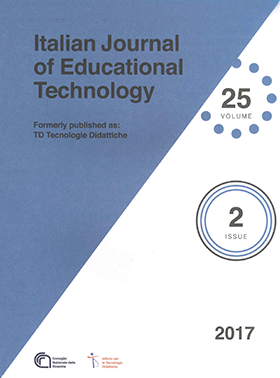Dal mestiere dell’informatico al pensiero computazionale
Contenuto principale dell'articolo
Abstract
Nel seguito viene proposta una breve analisi delle fasi in cui si articola lo sviluppo del software, dei metodi comunemente utilizzati dagli informatici in ciascuna di queste fasi e del possibile significato che queste modalità di pensiero possono assumere nei processi educativi. L’obiettivo è quello di offrire un quadro delle potenzialità educative del pensiero computazionale più ampio ed approfondito di quello che, in molti casi, è il modo di pensare corrente. Il pensiero computazionale si configura così come una abilità di portata generale che ha a che fare con l’astrazione, la rappresentazione, l’espressione e la comunicazione, e la capacità di indagine; e non viene confinato nella sola dimensione, importante ma restrittiva, della codifica in uno specifico linguaggio di programmazione.
Dettagli dell'articolo
Sezione
Gli autori che pubblicano su questa rivista accettano le seguenti condizioni:
- Gli autori mantengono i diritti sulla loro opera e cedono alla rivista il diritto di prima pubblicazione dell'opera, contemporaneamente licenziata sotto una Licenza Creative Commons CC BY 4.0 Attribution 4.0 International License.
- Gli autori possono aderire ad altri accordi di licenza non esclusiva per la distribuzione della versione dell'opera pubblicata (es. depositarla in un archivio istituzionale o pubblicarla in una monografia), a patto di indicare che la prima pubblicazione è avvenuta su questa rivista.
- Gli autori possono diffondere la loro opera online (es. in repository istituzionali o nel loro sito web) prima e durante il processo di submission, poiché può portare a scambi produttivi e aumentare le citazioni dell'opera pubblicata (Vedi The effect of Open Access).
Riferimenti bibliografici
Abell, S. K. (2008). Twenty years later: Does pedagogical content knowledge remain a useful idea?. International Journal of Science Education, 30(10), 1405-1416. doi:10.1080/09500690802187041
Ammann, D. P., & Offut, J. (2017). Introduction to Software Testing. Cambridge, UK:Cambridge University Press.
Barr, D., Harrison, J., & Conery, L. (2011). Computational Thinking: A Digital Age Skill for Everyone. Learning & Leading with Technology, 38(6), 20–23. Retrieved from http://www.iste.org/docs/learningand-leading-docs/march-2011-computational-thinking-ll386.pdf
Bender, E., Hubwieser, P., Schaper, N., Margaritis, M., Berges, M., Ohrndorf, L., ... & Schubert, S. (2015). Towards a competency model for teaching computer science. Peabody Journal of Education, 90(4), 519-532. doi:10.1080/0161956X.2015.1068082
Bocconi, S., Chioccariello, A., Dettori, G., Ferrari, A., & Engelhardt, K. (2016). Developing computational thinking in compulsory education – Implications for policy and practice. EUR 28295 EN; doi:10.2791/792158
Brennan, K., & Resnick, M. (2012). New frameworks for studying and assessing the development of computational thinking. In Proceedings of the Congress of the American Educational Research Association (pp. 1-25). Vancouver, CA: American Educational Research Association. Retrieved from http://web.media.mit.edu/~kbrennan/files/Brennan_Resnick_AERA2012_CT.pdf
D’Amore B. (2014). Le tante soluzioni di un problema. La Vita Scolastica (GiuntiScuola), 69(1), 25. Retrieved from http://www.dm.unibo.it/rsddm/it/articoli/damore/838%20Le%20tante%20soluzioni%20di%20un%20problema.pdf
D’Amore B., & Fandiño Pinilla, M. I. (2006). Che problema i problemi! L’insegnamento della matematica e delle scienze integrate, 29(6), 647. Retrieved from http://www.dm.unibo.it/rsddm/it/articoli/damore/588%20%20Problemi.pdf
Demo, B. G. (2013, July). Reading data schemas and knowing a db query interface in non technical secondary schools. Paper presented at X World Conference on Computers in Education, Toruń, Poland (pp. 112-120). Retrieved from http://wcce2013.umk.pl/publications/v2/V2.14_196-Demo-fullN.pdf
European Commission (2015). Relazione congiunta del Consiglio e della Commissione sull’attuazione del quadro strategico per la cooperazione europea nel settore dell’istruzione e della formazione (ET 2020) — Nuove priorità per la cooperazione europea nel settore dell’istruzione e della formazione. Gazzetta Ufficiale dell’Unione Europea. Retrieved from http://eur-lex.europa.eu/legal-content/IT/TXT/PDF/?uri=CELEX:52015XG1215(02)&from=IT
European Commission. (2016). A new skills agenda for Europe. Working together to strengthen human capital, employability and competitiveness. Gazzetta Ufficiale dell’Unione Europea. Retrieved from https://ec.europa.eu/transparency/regdoc/rep/1/2016/EN/1-2016-381-EN-F1-1.PDF
Fowler M. and Highsmith J. (2001). The Agile Manifesto. Retrieved from http://agilemanifesto.org/
Halpern, D. (2003). Thought and knowledge: An introduction to critical thinking (4th edition). Mahwah, NJ: Earlbaum.
O. Hazzan, T. Lapidot, N. Ragonis (2014). A Guide to Teaching Computer Science. London, UK: Springer-Verlag
Klahr, D., & Carver, S. M. (1988). Cognitive objectives in a LOGO debugging curriculum: Instruction, learning, and transfer. Cognitive Psychology, 20(3), 362-404. doi:10.1016/0010-0285(88)90004-7
Manilla L., Dagiene, V., Demo, B., Grgurina, N., Mirolo, C., Rolandsson, L., & Settle, A. (2014). Computational Thinking in K-9 Education. In M. Goldweber (Ed.), ITiCSE-WGR ‘14 Proceedings of the Working Group Reports of the 2014 on Innovation & Technology in Computer Science Education Conference (pp. 1-29). Uppsala, SE: Uppsala Universitet. doi:10.1145/2713609.2713610
Olimpo G. (2011). Information flows and graphic knowledge representations. Trentin G. (Eds.), Technology and knowledge flows: the power of network (pp. 91-132). Oxford, UK: Chandos Publishing.
Olimpo, G. (2015). Pensiero computazionale = buona programmazione e non solo. In V. Midoro (Ed.), La scuola ai tempi del digitale (pp. 60-84). Milano, IT: Franco Angeli Editore.
Papert, S. (1980). Mindstorms: Children, computers, and powerful ideas. New York, NY: Basic Books.
Parnas D. (1972). On the criteria to be used in decomposing systems into modules. Communications of the ACM, 14(1), 1053-1058. Retrieved from https://www.cs.umd.edu/class/spring2003/cmsc838p/Design/criteria.pdf
Polya G. (1945). How to Solve It. Princeton, NJ: Princeton University Press (trad. it. Come risolvere i problemi di matematica, UTET Università, Torino, 2016).
Peyton Jones, S., Mitchell, B., & Humphreys, S. (2013, April). Computing at school in the UK. Microsoft Research Paper, 4. Retrieved from https://www.microsoft.com/en-us/research/wp-content/uploads/2016/07/ComputingAtSchoolCACM.pdf
Strödter, C. (2012, November). Data modeling and database systems as part of general education in CSE. In Proceedings of the 7th Workshop in Primary and Secondary Computing Education (pp. 137-140). New York, NY: ACM. doi:10.1145/2481449.2481481
The Royal Society. (2012). Shut down or restart? The way forward for computing in UK Schools. London, UK: The Royal Society. Retrieved from https://royalsociety.org/~/media/education/computing-in-schools/2012-01-12-computing-in-schools.pdf
Verborgh, R. (2013). Programming is an art [blog post]. Retrieved from http://ruben.verborgh.org/blog/2013/02/21/programming-is-an-art/
Weintrop, D., Beheshti, E., Horn, M., Orton, K., Jona, K., Trouille, L., & Wilensky, U. (2016). Defining computational thinking for mathematics and science classrooms. Journal of Science Education and Technology, 25(1), 127-147. doi:10.1007/s10956-015-9581-5
Wing, J. M. (2006). Computational thinking. Communications of the ACM, 49(3), 33-35. doi:10.1145/1118178.1118215
Wing J. (2017). Computational Thinking’s Influence on Research and Education for All. International Journal of Educational Technology, 25(2). doi:10.17471/2499-4324/922

